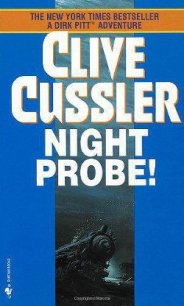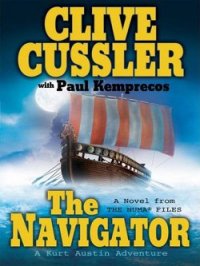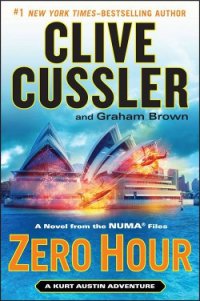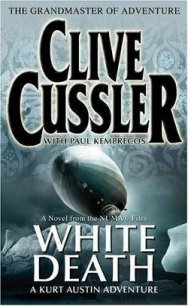Inca Gold - Cussler Clive (читать онлайн полную книгу .TXT) 📗
"The engravings on the suit have to be translated. The Inca did not have a method of writing or illustrating events like the Mayans, but photographs of the suit taken before its earlier theft from Spain show definite indications of a pictorial graphic system. The thieves will need the services of an expert to decode these glyphs. Interpretation of ancient pictographs is not exactly an overcrowded field."
"So you're going to chase down whoever gets the job?"
"Hardly a major effort. There are only five leading specialists. Two of them are a husband and wife team by the name of Moore. They're considered the best in the field."
"You've done your homework."
Gaskill shrugged. "The greed of the thieves is the only lead I've got."
"If you require the services of the bureau," Ragsdale said, "you have only to call me."
"I appreciate that, Francis, thank you."
"There's one other thing."
"Yes?"
"Can you introduce me to the chef? I'd like an inside track on a table for Saturday night."
After a short layover at the Lima airport to pick up the EG&G magnetometer that was flown in from the Deep Fathom by a U.S. Embassy helicopter, Pitt, Giordino, and Gunn boarded a commercial flight to Quito, the capital of Ecuador. It was after two o'clock in the morning when they landed in the middle of a thunderstorm. As soon as they stepped through the gate they were met by a representative of the state oil company, who was acting on behalf of the managing director Gunn had negotiated with for a helicopter. He quickly herded them into a limousine that drove to the opposite side of the field, followed by a small van carrying their luggage and electronic equipment. The two-vehicle convoy stopped in front of a fully serviced McDonnell Douglas Explorer helicopter. As they exited the limo, Rudi Gunn turned to express his appreciation, but the oil company official had rolled up the window and ordered the driver to move on.
"Makes one want to lead a clean life," Giordino muttered at the efficiency of it all.
"They owed us bigger than I thought," said Pitt, ignoring the downpour and staring blissfully at the big, red, twin-engined helicopter with no tail rotor.
"Is it a good aircraft?" asked Gunn naively.
"Only the finest rotorcraft in the sky today," replied Pitt. "Stable, reliable, and smooth as oil on water. Costs about two point seven-five million. We couldn't have asked for a better machine to conduct a search and survey project from the air."
"How far to the Bay of Caraquez?"
"About two hundred and ten kilometers. We can make it in less than an hour with this machine."
"I hope you don't plan to fly over strange terrain in the dark during a tropical storm," Gunn said uneasily, holding a newspaper over his head as a shield against the rain.
Pitt shook his head. "No, we'll wait for first light."
Giordino nodded toward the helicopter. "If I know only one thing, it's not to take a shower with my clothes on. I recommend we throw our baggage and electronic gear on board and get a few hours sleep before dawn."
"That's the best idea I've heard all day," Pitt agreed heartily.
Once their equipment was stowed, Giordino and Gunn reclined the backrests of two passenger seats and fell asleep within minutes. Pitt sat in the pilot's seat under a small lamp and studied the data accumulated by Perlmutter and Yaeger. He was too excited to be tired, certainly not on the eve of a shipwreck search. Most men turn from Jekyll to Hyde whenever the thought of a treasure hunt floods their brain. But Pitt's stimulant was not greed but the challenge of entering the unknown to pursue a trail laid down by adventurous men like him, who lived and died in another era, men who left a mystery for later generations to unravel.
What kind of men walked the decks of sixteenth-century ships, he wondered. Besides the lure of adventure and the remote prospect of riches, what possessed them to sail on voyages sometimes lasting three or more years on ships not much larger than a modest suburban, two-story house? Out of sight of land for months at a time, their teeth falling out from the ravages of scurvy, the crews were decimated by malnutrition and disease. Many were the voyages completed by only ship's officers, who had survived on more abundant rations than the common seamen. Of the eighty-eight men on board the Golden Hind when Drake battled through the Strait of Magellan into the Pacific, only fifty-six were left when he entered Plymouth Harbor.
Pitt turned his attention to the Nuestra Senora de la Concepcion. Perlmutter had included illustrations and cutaway plans of atypical Spanish treasure galleon that sailed the seas during the sixteenth and seventeenth centuries. Pitt's primary interest was in the amount of iron that was on board for the magnetometer to detect. Perlmutter was certain the two cannon she reportedly carried were bronze and would not register on an instrument that measures the intensity of the magnetic field produced by an iron mass.
The galleon carried four anchors. Their shanks, arms, and flukes were cast from iron, but their stocks were wood and they were secured to hemp lines, not chains. If she had been riding on two anchors, the force of the wave, suddenly striking the ship and hurling it ashore, would have probably snapped the lines. That left a small chance her two spare anchors might have survived intact and still be somewhere in the wreckage.
He totaled up the rest of the iron that might have been on board. The fittings, ship's hardware, the big gudgeons and pintles that held the rudder and allowed it to turn. The trusses (iron brackets that helped support the yards or spars), any shackles or grappling irons. The cook's kettle, carpenter's tools, maybe a keg of nails, small firearms, swords, and pikes. Shot for the cannon.
It was an exercise in the dark. Pitt was hardly an authority on sixteenth-century sailing ships. He could only rely on Perlmutter's best guess as to the total iron mass on board the Concepcion. The best estimate ran between one and three tons. Enough, Pitt fervently hoped, for the magnetometer to detect the galleon's anomaly from 50 to 75 meters in the air.
Anything less, and they'd stand about as much chance of locating the galleon as they would of finding a floating bottle with a message in the middle of the South Pacific.
It was about five in the morning, with a light blue sky turning orange over the mountains to the east, as Pitt swung the McDonnell Douglas Explorer helicopter over the waters of the Bay of Caraquez. Fishing boats were leaving the bay and heading out to sea for the day's catch. The crewmen paused as they readied their nets, looked up at the low-flying aircraft and waved. Pitt waved back as the shadow of the Explorer flickered over the little fishing fleet and darted toward the coastline. The dark, radiant blue of deep water soon altered to a turquoise green streaked by long lines of breaking surf that materialized as the seafloor rose to meet the sandy beach.
The long arms of the bay circled and stopped short of each other at the entrance to the Chone River. Giordino, who was sitting in the copilot's seat, pointed down to the right at a small town with tiny streets and colorfully painted boats drawn up on the beach. The town was surrounded by numerous farms no larger than three or four acres, with little whitewashed adobe houses next to corrals holding goats and a few cows. Pitt followed the river upstream for two kilometers where it foamed white with rapids. Then suddenly the dense rain forest rose like an impenetrable wall and stretched eastward as far as they could see. Except for the river, no opening beneath the trees could be seen.




